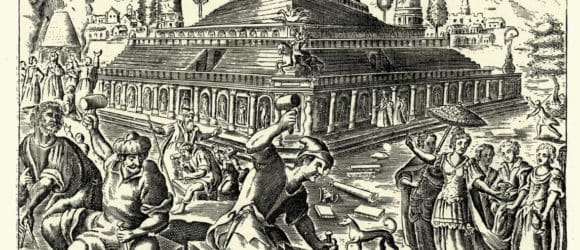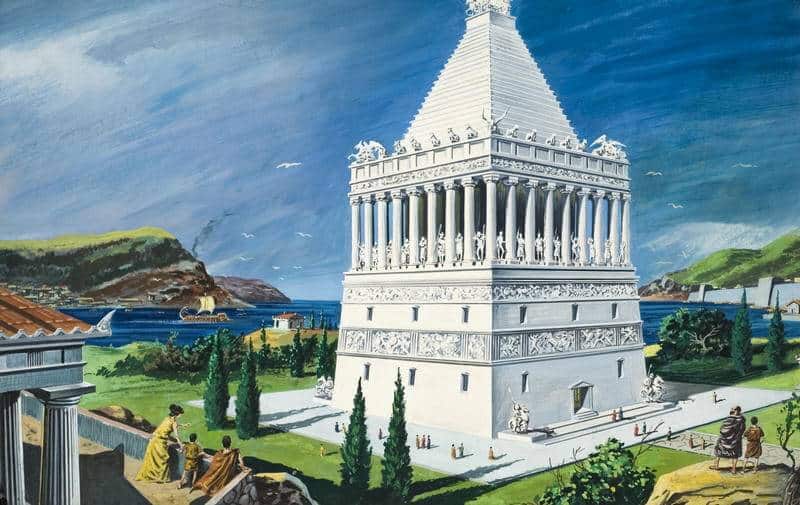History of the Mausoleum at Halicarnassus
History of the Mausoleum at Halicarnassus


Consider the following story about the Mausoleum at Halicarnassus – a structure so magnificent that it altered the English language.
The Halicarnassus Mausoleum
Mausolus (Mausolos or Mausollos) was a 4th Century Persian governor who ruled Caria, a region that is now modern-day Turkey. He and his sister/wife Artemisia expanded into the surrounding territory throughout their reign, taking control of several neighboring cities and districts. During one such invasion, Mausolus was inspired by the beauty of “pillar tombs,” known as the Tombs at Xanthos in Lycia.
As their wealth grew, Mausolus decided to build a magnificent new capital city in Halicarnassus. Artemisia and Mausolus spent massive amounts of tax money to embellish the city with polished marble statues, temples, and buildings. In addition, they built a new harbor, a network of roads, and palaces, making them one of the greatest leaders of the ages.
Remembering the Tombs at Xanthos, Mausolus was inspired to begin work on his own elaborate tomb on a hill overlooking the city. The project was enormous. (Read more about the scope of the project from the World History Encyclopedia). The tomb’s massive roof was shaped like a pyramid. The whole structure sat in an enclosed courtyard. A stone platform holding the tomb sat in the middle of the square. Stone lions lined the stairway to the top of the platform. Its outer walls were lined with many statues of gods and goddesses. At each corner, stone warriors mounted on horseback guarded the tomb.

The structure was covered with a series of relief sculpture, which depicted detailed action scenes (including the battle of the Greeks in combat with the Amazons, a race of warrior women.)
The project was incomplete when Mausolus died in 353 BC. However, Mausolus’ sister/wife oversaw continued work on the tomb, sparing no expense for the project. She brought in the most the most talented artists of the time from Greece, including famous sculptors.
Two years after the death of Mausolus, Artemisia died. Their ashes were placed in the unfinished tomb, and the stairs leading to the room were sealed with stones. Even though the leaders were deceased, work continued on the beautiful tomb. The artisans realized they were part of something special. They wanted to complete their work to celebrate a great leader’s life and as a part of their legacy as artists.
The Origin of the Word Mausoleum
Once complete, ancient writers referred to the building as the Maussolleion and then the Mausoleum at Halicarnassus. The tomb was considered one of the most lavish personal mausoleum building projects ever created. In fact, the mausoleum began to be used for all stately tombs.
Mausoleum at Halicarnassus: One of the Seven Wonders of the Ancient World
In 225 BCE, a Greek writer wrote about seven amazing sites, which he labeled the Seven Wonders of the Ancient World. The list included items from Ancient Greece, including the large statue of Zeus at Olympia. But, of course, the list of ancient wonders also included one of the first massive tombs to celebrate the life of a human – the Mausoleum of Halicarnassus.
The mausoleum overlooked the city of Halicarnassus for many years. It was untouched when the city fell to Alexander the Great in 334 BC. Only after earthquakes shattered the columns and the Knights of St John of Rhodes invaded the region did the mausoleum begin to lose shape.
The knights used the marble blocks to fortify what was called Bodrum Castle. In 1522, rumors of a Turkish invasion caused Crusaders of the Middle Ages to strengthen the castle at Halicarnassus, and much of the remaining portions of the tomb were broken up and used in the castle walls. However, before building material was ground up from the remaining sculpture, the Knights entered the broken remains and removed numerous statues.
Visit Some of The Remains of the Mausoleum at Halicarnassus at the British Museum
Colossal free-standing statues and marble relief carvings from the mausoleum can be found today at the British Museum. Don’t forget to look for the fragments of the huge marble, four-horse chariot, and the broken stone chariot wheel that crowned the pyramid roof.
What Will Be Your Legacy?
As you consider the story of the Mausolus, ruler of the Persian Empire, think about the legacy he and his wife left behind. Not only did they build a great city, but their contributions also inspired a tomb of great beauty that celebrated their family’s history and was admired for centuries.
As you consider your legacy, request a consultation with the premier private mausoleum builder in North America – Forever Legacy. Create a thing of beauty to celebrate your family’s contributions to your community.
Belinda McLeod has a degree in Secondary Education, specializing in English and Journalism. She began her career as a freelance writer in 2018 since a flexible schedule would allow her to help care for an aging parent. Since then, Belinda has specialized in writing for the funeral industry. Belinda has written for Cake, a funeral-planning website, nursing homes, mausoleum companies, cremation companies, and funeral homes.






